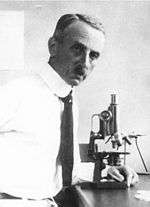Leo Loeb
| Leo Loeb | |
|---|---|
|
Leo Loeb, MD, in 1915. | |
| Born |
September 21, 1869 Mayen, Prussia (Germany) |
| Died |
December 28, 1959 (aged 90) St. Louis, Missouri, United States |
| Residence | St. Louis, Missouri |
| Citizenship | United States |
| Nationality | German; American |
| Fields | Medicine & Pathology |
| Institutions | Washington University in St. Louis, McGill University, University of Chicago, University of Illinois at Chicago, University of Pennsylvania |
| Alma mater | University of Zurich |
| Known for | Research on cancer & endocrinology |
Leo Loeb (September 21, 1869 – December 28, 1959), was an American physician, educator, and experimental pathologist.
Early life
Loeb, son of a Jewish family from the German Eifel region, was born in 1869 in Mayen, Prussia. He was orphaned as a child and grew up in the care of an uncle. Because of ill health, Leo was educated in schools that were located in German "spa" towns.[1] As a teenager, he enrolled at the University of Heidelberg, but his tenure there was short. Indeed, over the succeeding couple of years, he spent only brief periods at several universities, in Berlin, Freiburg, and Basel, unable to focus his interests. Finally, in 1890, Loeb entered the University of Zurich Medical School.[1] This time he remained in place, except for external sojourns to Edinburgh, London, and the United States for external clinical experiences. Leo received his M.D. in 1897. For his senior thesis, he had done research on skin transplantation in animals; that experience, combined with the influence of his older brother, Jacques, who was a physiologist, led Loeb to decide to pursue a career in experimental medicine.[1]
His brother had a teaching position at the University of Chicago, and Leo moved to that city from Europe after completing his medical degree. Following a brief period of practicing clinical medicine—which he disliked—Loeb took a position as a lecturer at the College of Medicine of the University of Illinois) and the University of Chicago. At those institutions, he taught experimental methodology, and, at intervals, was also a visiting scholar at Johns Hopkins University.[2] Loeb became interested in blood coagulation and the growth properties of malignant cells. As an outgrowth of the latter topic, Loeb developed the cell culture technique as applied to both normal and abnormal tissues.[3]
Loeb was next asked to join the faculty at McGill University in Montreal; however, that posting lasted only one year because of his inability to acclimatize himself to the harsh Canadian winter. He moved to the University of Pennsylvania in Philadelphia in 1903, beginning a series of important experiments on the influence on cancer growth by reproductive hormones.[1] In 1907, Loeb published a study which showed that breast carcinoma in mice could be hereditary,[3] as it is now known to be in some human cases.[4]
Career at Washington University
By 1910, Loeb had acquired a national reputation for his work on cancer.[3] He was invited to become the director of the Barnard Free Skin & Cancer Hospital in St. Louis, a center that was attached to Washington University. This was a novel institution, in that its emphasis was on clinical research, even though Barnard was indeed a hospital for humans.[1] Over the succeeding several years, Loeb showed clearly that the growth of certain epithelial malignancies in animals could be modulated by removal of the ovaries. That work predated clinical application of the same concept in human breast cancer by several decades.[5]
In 1915, Loeb was appointed as professor of comparative pathology at Washington University School of Medicine (WUSM). Having long deferred a family life to concentrate on his research, he finally married Dr. Georgiana Sands (another physician) in 1922, at the age of 53.[4] She became not only his spouse, but also his scientific, administrative, and literary partner for the remainder of their lives together. In 1924, Loeb was given the chairmanship of pathology at WUSM; thereafter, he continued his work on tissue transplantation and cell culture, as well as research on endocrine disease. Loeb was known as a patient, kind, and helpful mentor to younger colleagues in the department.[1]
Retirement and death
Loeb retired from doing active research in 1941, at the age of 72. From then on, he concentrated on the meaning of his findings in an increasingly existential context.[6] This train of thought was reflected in another publication, in 1945, of a book entitled The Biological Basis of Individuality.[7] Loeb proposed three levels of human thought-- "hypnosuggestion;" "reasoning thought;" and "thoughts and interests represented by problems of philosophy and science."
Loeb and his wife remained in St. Louis until his death at the age of 90 in 1959.[4]
References
- 1 2 3 4 5 6 P. G. Anderson. "Leo Loeb, 1869–1959". Retrieved 1 September 2009.
- ↑ Suntzeff V: Obituary-- Leo Loeb, 1869-1959. Cancer Res 1960; 20: 972-973.
- 1 2 3 Goodpasture EW: Leo Loeb, 1869-1959: a biographic memoir. Natl Acad Sci USA, Washington, D.C., 1961.
- 1 2 3 Kenemans P, Verstraeten RA, Verheijen RH. Oncogenic pathways in hereditary and sporadic breast cancer. Maturitas 2008; 61: 141-150.
- ↑ Galante M, McCorkle HJ: Clinical evaluation of bilateral adrenalectomy and oophorectomy for advanced mammary carcinoma. Am J Surg 1955; 90: 180-188.
- ↑ Loeb L: Autobiographical notes. Perspect Biol Med 1958; 2: 1-23.
- ↑ Loeb L: The Biological Basis of Individuality, C.C. Thomas, Springfield, IL, 1945.
External links
| Wikisource has the text of a 1920 Encyclopedia Americana article about Leo Loeb. |
